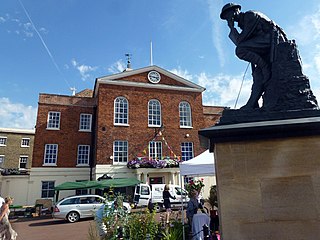
Huntingdon is a market town in the Huntingdonshire district of Cambridgeshire, England. The town was given its town charter by King John in 1205. It was the county town of the historic county of Huntingdonshire. Oliver Cromwell was born there in 1599 and became one of its Members of Parliament (MP) in 1628. The former Conservative Prime Minister (1990–1997) John Major served as its MP from 1979 until his retirement in 2001.

Godmanchester is a town and civil parish in the Huntingdonshire district of Cambridgeshire, England. It is separated from Huntingdon, 1 mile (1.6 km) to the north, by the valley of the River Great Ouse. Being on the Roman road network, the town has a long history. It has a waterside location, surrounded by open countryside of high value for its biodiversity but it remains highly accessible, with a railway line to London, the A1 road and M11/A14 which run nearby.

Eynesbury is an urban area forming part of St Neots, in the civil parish of St Neots, in the Huntingdonshire district, in the county of Cambridgeshire, England. It mainly consists of housing, although there is an area of light industry, and a large supermarket. Eynesbury is home to Ernulf Academy and a fitness centre called One Leisure. In addition there is a large area of open grassland and a caravan park. In earlier times Eynesbury was a distinct area, but nowadays it is considered to be a subdivision of St Neots.
Cambourne is a new settlement and civil parish in Cambridgeshire, England, in the district of South Cambridgeshire. It lies on the A428 road between Cambridge, 9 miles (14 km) to the east, and St Neots and Bedford to the west. It comprises the three villages of Great Cambourne, Lower Cambourne and Upper Cambourne. The area is close to Bourn Airfield.

Little Gransden is a civil parish and village in South Cambridgeshire, England. In 2001 the population was 262 people, including Waresley and increasing to 296 at the 2011 Census. It is 11 miles (18 km) from Cambridge, on the border with the district of Huntingdonshire. Little Gransden has two airfields, one of which was used in World War II.
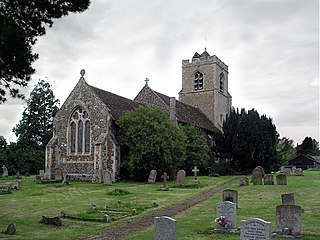
Caxton is a small rural village and civil parish in the South Cambridgeshire district of Cambridgeshire, England. It is 9 miles west of the county town of Cambridge. In 2001, the population of Caxton parish was 480 people, increasing to 572 at the 2011 Census. Caxton is most famous for the Caxton Gibbet.

Cottenham is a village in Cambridgeshire, England. Cottenham is one of the larger villages surrounding the city of Cambridge, located around five miles north of the city. The population of the civil parish at the 2011 Census was 6,095. Cottenham is one of a number of villages that make up the historical Fen Edge region in between Cambridge and Ely, which were originally settlements on the shore of the marshes close to the city of Cambridge, then an inland port.
Sawtry is a village and civil parish in Cambridgeshire, England. Sawtry lies approximately 8 miles (13 km) north of Huntingdon. Sawtry is situated within Huntingdonshire which is a non-metropolitan district of Cambridgeshire as well as being a historic county of England. The village is home to over 6,000 people.

The A1198 is a road in Cambridgeshire, England, which runs between the A505 at Royston, and the A1307 on the outskirts of Huntingdon.
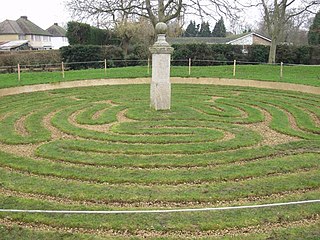
Hilton is a village and civil parish in Cambridgeshire, England. Hilton lies approximately 11 miles (18 km) north-west of Cambridge. Hilton is situated within Huntingdonshire, which is a non-metropolitan district of Cambridgeshire as well as being a historic county of England. The parish adjoins those of Elsworth, Fenstanton, Hemingford Abbots, Hemingford Grey, Papworth Everard and Papworth St Agnes. The Church of England parish church is dedicated to St Mary Magdalene and is a Grade I listed building; it has a peal of six bells. Historically, the village was in Huntingdonshire for over 1,000 years until 1974.

Barham is a village and former civil parish, now in the parish of Barham and Woolley, in Cambridgeshire, England. Barham lies approximately 7 miles (11 km) west of Huntingdon. Barham is situated within Huntingdonshire which is a non-metropolitan district of Cambridgeshire as well as being a historic county of England. In 1931 the parish had a population of 34.
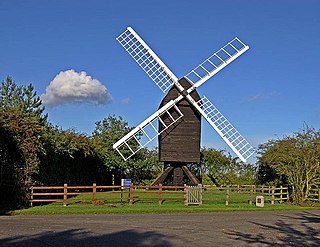
Great Gransden is a civil parish and village in the Huntingdonshire district of Cambridgeshire, England. In 2001, the parish population was 969, which rose to 1,023 at the 2011 Census. It lies 16 miles (25 km) west of Cambridge and 13 miles (21 km) south of Huntingdon. It contains the oldest post mill in England.
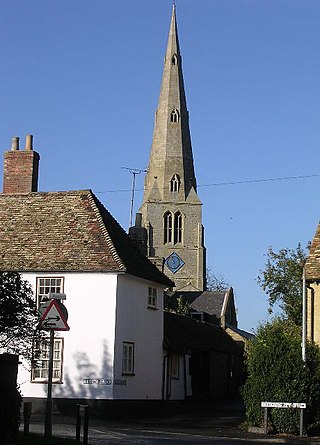
Spaldwick is a village and civil parish in Cambridgeshire, England. Spaldwick lies approximately 6 miles (10 km) west of Huntingdon, near Catworth. Spaldwick is situated within Huntingdonshire which is a non-metropolitan district of Cambridgeshire as well as being a historic county of England.
Bassingbourn cum Kneesworth is a civil parish in the South Cambridgeshire district of Cambridgeshire, England, 14 miles south-west of Cambridge and just north of Royston, Hertfordshire. Since the 1960s the parish contains the villages of Bassingbourn and Kneesworth.
Rampton is a village in Cambridgeshire, England, situated on the edge of The Fens six miles to the north of Cambridge.
Earith is a village and civil parish in Cambridgeshire, England. Lying approximately 10 miles (16 km) east of Huntingdon, Earith is situated within Huntingdonshire which is a non-metropolitan district of Cambridgeshire as well as being a historic county of England. At Earith, two artificial diversion channels of the River Great Ouse, the Old Bedford River and the New Bedford River, leave the river on a course to Denver Sluice near Downham Market, where they rejoin the Great Ouse in its tidal part. At the 2001 census, the parish had a population of 1,677, reducing to 1,606 at the 2011 Census.

Eltisley is a village and civil parish in South Cambridgeshire, England, on the A428 road about 5.5 miles (8.9 km) east of St Neots and about 11 miles (18 km) west of the city of Cambridge. The population in 2001 was 421 people, falling slightly to 401 at the 2011 Census.
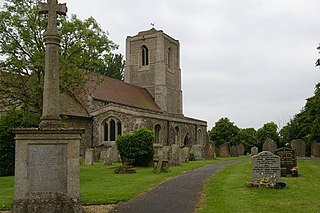
Great Stukeley is a village and former civil parish, now in the parish of The Stukeleys. It is 1.8 miles (2.9 km) north-west of Huntingdon. Great Stukeley is in Huntingdonshire which is a non-metropolitan district of Cambridgeshire as well as a historic county of England. It lies on the old Roman road of Ermine Street. In 1931 the parish had a population of 354.
Papworth St Agnes is a village and civil parish in South Cambridgeshire, England. The population of the village is included in the civil parish of Graveley It has also been known as Papworth Magna, to distinguish it from the adjoining Papworth Everard and Papworth Parva. The name of the village does not come from any church of St Agnes, but from a certain Agnes de Papewurda, c1160.


















